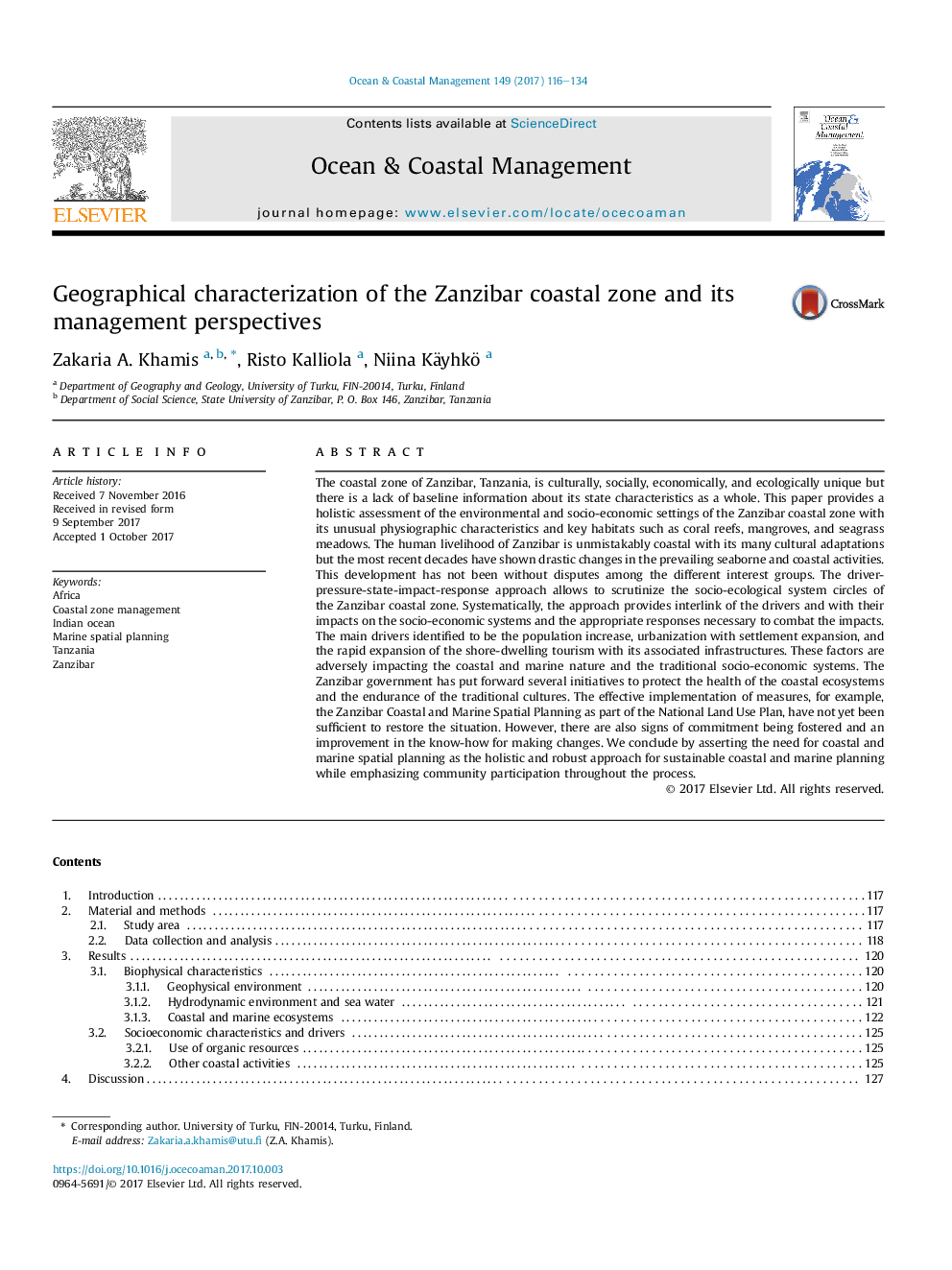| کد مقاله | کد نشریه | سال انتشار | مقاله انگلیسی | نسخه تمام متن |
|---|---|---|---|---|
| 5473802 | 1520480 | 2017 | 19 صفحه PDF | دانلود رایگان |
عنوان انگلیسی مقاله ISI
Geographical characterization of the Zanzibar coastal zone and its management perspectives
ترجمه فارسی عنوان
مشخصات جغرافیایی منطقه ساحلی زنگبار و دیدگاه های مدیریت آن
دانلود مقاله + سفارش ترجمه
دانلود مقاله ISI انگلیسی
رایگان برای ایرانیان
کلمات کلیدی
آفریقا، مدیریت منطقه ساحلی، اقیانوس هند، برنامه ریزی فضایی دریایی، تانزانیا، زنگبار،
ترجمه چکیده
منطقه ساحلی زنگبار، تانزانیا، از لحاظ فرهنگی، اجتماعی، اقتصادی و از لحاظ زیست محیطی منحصر به فرد است، اما اطلاعات پایه ای در مورد ویژگی های دولت به طور کلی وجود ندارد. این مقاله یک ارزیابی جامع از محیط زیست و شرایط اجتماعی و اقتصادی ساحلی زنگبار با ویژگی های فیزیکی غیر معمول و زیستگاه های کلیدی مانند صخره های مرجانی، مانگرو ها و مراتع سایگون را ارائه می دهد. معیشت انسانی زنگبار با توجه به سازگاری های فرهنگی بسیاری است که ساکنان آن است اما دهه های اخیر تغییرات شدید در فعالیت های دریایی و ساحلی را نشان داده اند. این پیشرفت بدون اختلاف در میان گروه های مختلف منافع صورت نگرفته است. رویکرد راننده-فشار-دولت-تأثیر-پاسخ اجازه می دهد تا دایره های زیست محیطی زیستبار را بررسی کنید. به طور سیستماتیک، این رویکرد، ارتباط بین رانندگان و تأثیرات آنها را در سیستم های اجتماعی-اقتصادی و پاسخ های مناسب برای مبارزه با تأثیرات فراهم می کند. رانندگان اصلی، افزایش جمعیت، شهرنشینی با گسترش شهرک ها و گسترش سریع گردشگری ساحلی ساحلی با زیرساخت های مربوطه را مشخص می کنند. این عوامل بر طبیعت ساحلی و دریایی و سیستم های اقتصادی و اجتماعی سنتی تاثیر می گذارد. دولت زنگبار چندین طرح برای حفاظت از سلامت اکوسیستم های ساحلی و استقامت فرهنگ های سنتی ارائه کرده است. اجرای موثر اقدامات، به عنوان مثال، برنامه ریزی فضایی ساحلی و دریایی زنگبار به عنوان بخشی از برنامه ملی استفاده از زمین، هنوز برای بازگرداندن وضعیت کافی نیست. با این حال، نشانه هایی از تعهد به وجود آورده شده است و پیشرفت دانش فنی برای ایجاد تغییرات وجود دارد. ما با بیان نیاز به برنامه ریزی فضایی ساحلی و دریایی به عنوان رویکرد جامع و قوی برای برنامه ریزی ساحلی ساحلی و دریایی با تأکید بر مشارکت جامعه در طول فرایند، نتیجه می گیریم.
موضوعات مرتبط
مهندسی و علوم پایه
علوم زمین و سیارات
اقیانوس شناسی
چکیده انگلیسی
The coastal zone of Zanzibar, Tanzania, is culturally, socially, economically, and ecologically unique but there is a lack of baseline information about its state characteristics as a whole. This paper provides a holistic assessment of the environmental and socio-economic settings of the Zanzibar coastal zone with its unusual physiographic characteristics and key habitats such as coral reefs, mangroves, and seagrass meadows. The human livelihood of Zanzibar is unmistakably coastal with its many cultural adaptations but the most recent decades have shown drastic changes in the prevailing seaborne and coastal activities. This development has not been without disputes among the different interest groups. The driver-pressure-state-impact-response approach allows to scrutinize the socio-ecological system circles of the Zanzibar coastal zone. Systematically, the approach provides interlink of the drivers and with their impacts on the socio-economic systems and the appropriate responses necessary to combat the impacts. The main drivers identified to be the population increase, urbanization with settlement expansion, and the rapid expansion of the shore-dwelling tourism with its associated infrastructures. These factors are adversely impacting the coastal and marine nature and the traditional socio-economic systems. The Zanzibar government has put forward several initiatives to protect the health of the coastal ecosystems and the endurance of the traditional cultures. The effective implementation of measures, for example, the Zanzibar Coastal and Marine Spatial Planning as part of the National Land Use Plan, have not yet been sufficient to restore the situation. However, there are also signs of commitment being fostered and an improvement in the know-how for making changes. We conclude by asserting the need for coastal and marine spatial planning as the holistic and robust approach for sustainable coastal and marine planning while emphasizing community participation throughout the process.
ناشر
Database: Elsevier - ScienceDirect (ساینس دایرکت)
Journal: Ocean & Coastal Management - Volume 149, 15 November 2017, Pages 116-134
Journal: Ocean & Coastal Management - Volume 149, 15 November 2017, Pages 116-134
نویسندگان
Zakaria A. Khamis, Risto Kalliola, Niina Käyhkö,
